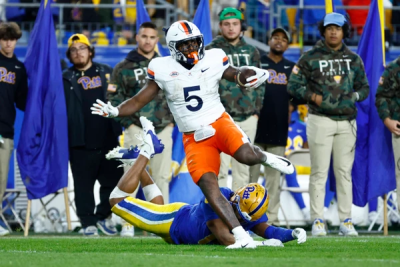What’s Virginia’s secret to being unbeaten after bye weeks?
By Jerry Ratcliffe
Tony Elliott is undefeated as Virginia’s head coach when coming off a bye week, 4-0, with two of those wins coming against nationally ranked teams.
If Elliott has a secret sauce for bye weeks, he’s keeping it to himself. Some of the adjustments and wrinkles that he and his staff threw at No. 18 (CFP rankings) Pitt last weekend were brilliant, and the Panthers had no answer.
UVA is a 23-point underdog at No. 8 Notre Dame this Saturday (3:30 p.m., nationally televised by NBC), and the Cavaliers will have to put Pitt in the rear view, but hand it to Elliott and staff for outcoaching Pitt.
We asked Elliott this week if he had a formula for getting the utmost out of a bye week, and while he pointed out some things he does, he wouldn’t reveal everything.
Still, Virginia threw a lot of new wrinkles at the Panthers, including an unbalanced line — with Jack Witmer, McKale Boley and Noah Josey all lined up to the left of center Brian Stevens — for some successful gains and a touchdown.
Of course, there was the fake quarterback draw with Anthony Colandrea, with the sophomore QB suddenly stopping, raising up for a “pop pass” to a wide-open Xavier Brown in the end zone for a 14-13 lead.
Then there was the run by Kobe Pace for a first down out of the “Grady Bunch” formation, where Virginia normally has reserve QB Grady Brosterhaus sneaking the ball, getting pushed from behind by his teammates, a “Tush Push.” That was part of an 18-play, clock-draining drive from UVA’s 25, resulting in a field goal and a 24-19 lead with only 2:04 remaining on the clock.
Of course, the Pace first-down run was controversial because Virginia was given a second chance after failing on the previous play — a true sneak by Brosterhaus — when the ball was snapped before game officials were ready.
Officials said the down would be replayed because some of them were not in position, which is correct by the rules but incredibly rare, and drew protests from Pitt coach Pat Narduzzi.
All these wrinkles came from extensive research and film study by UVA’s coaching staff, looking for certain looks in some cases by Pitt’s defenses, leaving the Panthers vulnerable.
As far as Virginia’s defense was concerned, coordinator John Rudzinski obviously saw some things that SMU used to hammer previously unbeaten Pitt the week before, and employed some of those tactics successfully to see if the Panthers corrected the problem.
One of those strategies was to use a lighter defensive front from time to time, putting smaller but quicker players, his best four pass rushers (Ben Smiley, Kam Butler, Terrell Jones and Chico Bennett) on the front, presenting problems for Pitt’s offensive line.
The Panthers couldn’t block them, couldn’t handle their stunts and blitzes, forcing two Pitt QBs into disrupted timing and mistakes in the passing game.
“I don’t know if there’s a secret sauce, but I think the time helps our bodies and then it just gives us a chance to get a good gameplan together, and then also have a better idea of what we’re tipping and giving away to the opposing teams,” Elliott said.
Three of those four wins after byes have been against Pitt and Boston College this season, and an upset last year in Chapel Hill when the Cavaliers stunned No. 10 and undefeated North Carolina.
Virginia does some typical things during a bye week, such as self-scouting, picking up on tendencies, focusing on what the team has done well recently and eliminating things that haven’t worked.
Naturally, the extra week allows banged-up players more time to get healthy, a chance to breathe, and allows coaches time to develop some of the younger players in practice.
Most certainly, Elliott and staff are pretty good at finding things that will work against opponents.
How else can you explain that Virginia picked up 170 yards on the ground against a Pitt defense ranked No. 7 in the nation in stopping the run? The Cavaliers ran the ball 42 times.
UVA’s defense held Pitt’s offense — which was averaging 39 points per game — to a mere 19 points, the Panthers’ second-lowest output of the season. This was a Pitt team that was unbeaten two weeks before facing SMU and UVA.
Elliott & Co. must have seen some things on video that made them believe they could successfully run against a team that likes to load up more defenders in the tackle box than the O-Line can block.
Virginia’s short passing game to the flanks impacted this to a degree because Pitt game-planned to take that away from the Cavaliers’ offense, which may have made it a little easier to run the ball. Pick your poison, right?
“Going into the game, we said we had to establish the run, and you have to be honest with yourself that you’re going to go in there and pound it down the throat versus Pitt, and that’s not realistic because of their structure,” Elliott said.
The coach said his O-Line was committed and displayed great chemistry to open gaps for the UVA backs and that in turn, the backs ran hard, turning 3- and 4-yard gains into 7- and 8-yard pickups, particularly on second down, leaving Colandrea with third-and-short. Colandrea also did a terrific job of running the ball, keeping Pitt’s defense on its heels.
“Once we saw we were having success running the ball, we stuck with it,” Elliott said. “We needed to be effective and efficient to keep [Pitt] honest so that we could set up some play-action, but I think the guys took ownership of the line of scrimmage.
“Creates some running gains and the backs ran hard through arm tackles and broke plays for us. And the quarterback did a really good job when we asked him to run the ball.”
Virginia will try to do the same at Notre Dame this week, but the challenge will be tougher with the Irish presenting a bigger, more physical defense that is ranked high nationally in most categories.









